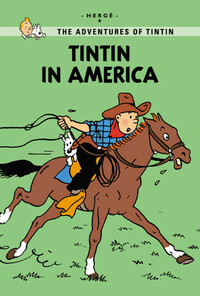Take a photo of a barcode or cover
A little bit rough around the edges compared to his later work. A lot of forced drama and sheer luck.
adventurous
fast-paced
Plot or Character Driven:
Plot
Strong character development:
No
Loveable characters:
Complicated
Diverse cast of characters:
No
Flaws of characters a main focus:
No
Better than Tintin in the Land of the Soviets, but really, any actual Tintin story wipes the floor with that dog's breakfast. Tintin himself feels more like the character we know. This story is a whirlwind of unlikely escapes and facile stereotypes of early 20th century America, but I can't shake the feeling that there's just not much of a story at its core. Honestly, this is probably one of the more skippable Tintin books.
Portrayal of Indigenous people is far from good. Not surprising, considering when and where it was made, but if you don't like what you see on the cover (and I don't blame you), avoid this.
Tintin is so funny. It's hilarious how he gets out of competely impossible situations. The only negative aspect is that parts of it could be considered as discrimination.
adventurous
fast-paced
Tras Tintín en el Congo, el famoso reportero viaja a América para terminar de una vez por todas con la red de contrabando de diamantes que dirige el mismísimo Al Capone.
En esta tercera entrega (1931 a 1932) encontramos al fin algo parecido a un argumento o hilo conductor, pero Hergé falla al darle cohesión y vuelve a leerse como una sucesión de persecuciones, secuestros, peleas, torturas e intentos de asesinato que terminan convirtiendo la historia en una aventura tediosa.
Si lo comparamos con los dos anteriores volúmenes, Tintín en América supone una mejora, y tiene algunas escenas bastante logradas, pero la mezcla de temas no tiene mucho sentido, introduciendo todos los tópicos norteamericanos existentes uno tras otro. La mafia y los indios son una mezcla rara, pero más lo es la crítica al materialismo y capitalismo feroz norteamericano y la denuncia del trato que los nativos americanos recibieron por un lado, y la visión simplista que da sobre ellos y el racismo del propio Milú por el otro (si se figuran que voy a dirigirles la palabra a unos perros pieles rojas...).
En esta tercera entrega (1931 a 1932) encontramos al fin algo parecido a un argumento o hilo conductor, pero Hergé falla al darle cohesión y vuelve a leerse como una sucesión de persecuciones, secuestros, peleas, torturas e intentos de asesinato que terminan convirtiendo la historia en una aventura tediosa.
Si lo comparamos con los dos anteriores volúmenes, Tintín en América supone una mejora, y tiene algunas escenas bastante logradas, pero la mezcla de temas no tiene mucho sentido, introduciendo todos los tópicos norteamericanos existentes uno tras otro. La mafia y los indios son una mezcla rara, pero más lo es la crítica al materialismo y capitalismo feroz norteamericano y la denuncia del trato que los nativos americanos recibieron por un lado, y la visión simplista que da sobre ellos y el racismo del propio Milú por el otro (si se figuran que voy a dirigirles la palabra a unos perros pieles rojas...).
(English review below)
Je suis un grand fan de la série Tintin de Hergé. Quand j’étais enfant, je me rappelle lire ces bande-dessinées tout le temps avant d’aller au lit. J’ai récemment décidé de me relancer dedans et voir ce que mon esprit d’adulte pense de tout cela!
Je tiens à préciser que toute personne voulant se lancer dans la série doit se rappeler du contexte historique de cette série et de l’époque à laquelle vivait l’auteur. Certains sujets peuvent être politiquement incorrecte de nos jours, et certains thèmes abordés peuvent être sensible.
Tintin en Amérique est le 3e volume de la série et on commence à vraiment voir le Tintin qu’on verra dans la suite de la série: rusé, habile, courageux et extrêmement chanceux. Accompagné bien sûr du fidèle Milou tout aussi courageux bien que naïf parfois sur les choses que font les humains. Cette aventure ressemble déjà davantage aux récits suivants avec des Syndicats de criminels poursuivis par Tintin.
Malheureusement, tout comme les deux volumes précédents (Tintin au Pays des Soviets et Tintin au Congo), ce volume est rempli de caricatures et clichés de l’époque sur l’Amérique: gangsters, armes à feux, corruption de la police, et bien sûr tous les stéréotypes possibles sur les Amérindiens… Hergé tente de couvrir une multitude de périodes de l’histoire de l’Amérique dans un seul volume, entre les cowboys du Far-Ouest, les gangsters et la ruée au pétrole, ce qui rend l’histoire très difficile à suivre.
Autant on commence à bien voir la direction que vont prendre les aventures de Tintin, il y a toujours une grande présence des thèmes inappropriés et stéréotypés.
————————————————
I am a huge fan of the Tintin series by Hergé. I remember often reading these comics before bed as a child. I have recently decided to give them another read and see what my adult self thinks of it!
I would like to remind anybody reading these about the historical context of the stories and the times the author was living in. Certain subject might be considered politically incorrect nowadays and some of the themes could be considered quite sensitive.
Tintin in America is the third volume in the series and we start to recognize the Tintin that we know from the rest of the series: cunning, agile, brave and extremely lucky! His loyal companion, Snowy, is also very courageous although sometimes quite naive on things humans do. This adventure is very representative of the following Tintin stories with Tintin seeking down criminal syndicates and such.
Unfortunately, in the same way the previous two volumes (Tintin in the Land of the Soviets and Tintin in the Congo), this book is riddled with caricatures and cliches of America at the time: gangsters, fire arms, police corruption, and of course all possible stereotypes on the indigenous people of America… Hergé attempts to cover many periods from America’s history in one book, blending cowboys, gangsters and the oil rush, making the story difficult to follow.
We start to see the direction the adventures of Tintin will take, but there is still a big presence of inappropriate and stereotypical themes.
Je suis un grand fan de la série Tintin de Hergé. Quand j’étais enfant, je me rappelle lire ces bande-dessinées tout le temps avant d’aller au lit. J’ai récemment décidé de me relancer dedans et voir ce que mon esprit d’adulte pense de tout cela!
Je tiens à préciser que toute personne voulant se lancer dans la série doit se rappeler du contexte historique de cette série et de l’époque à laquelle vivait l’auteur. Certains sujets peuvent être politiquement incorrecte de nos jours, et certains thèmes abordés peuvent être sensible.
Tintin en Amérique est le 3e volume de la série et on commence à vraiment voir le Tintin qu’on verra dans la suite de la série: rusé, habile, courageux et extrêmement chanceux. Accompagné bien sûr du fidèle Milou tout aussi courageux bien que naïf parfois sur les choses que font les humains. Cette aventure ressemble déjà davantage aux récits suivants avec des Syndicats de criminels poursuivis par Tintin.
Malheureusement, tout comme les deux volumes précédents (Tintin au Pays des Soviets et Tintin au Congo), ce volume est rempli de caricatures et clichés de l’époque sur l’Amérique: gangsters, armes à feux, corruption de la police, et bien sûr tous les stéréotypes possibles sur les Amérindiens… Hergé tente de couvrir une multitude de périodes de l’histoire de l’Amérique dans un seul volume, entre les cowboys du Far-Ouest, les gangsters et la ruée au pétrole, ce qui rend l’histoire très difficile à suivre.
Autant on commence à bien voir la direction que vont prendre les aventures de Tintin, il y a toujours une grande présence des thèmes inappropriés et stéréotypés.
————————————————
I am a huge fan of the Tintin series by Hergé. I remember often reading these comics before bed as a child. I have recently decided to give them another read and see what my adult self thinks of it!
I would like to remind anybody reading these about the historical context of the stories and the times the author was living in. Certain subject might be considered politically incorrect nowadays and some of the themes could be considered quite sensitive.
Tintin in America is the third volume in the series and we start to recognize the Tintin that we know from the rest of the series: cunning, agile, brave and extremely lucky! His loyal companion, Snowy, is also very courageous although sometimes quite naive on things humans do. This adventure is very representative of the following Tintin stories with Tintin seeking down criminal syndicates and such.
Unfortunately, in the same way the previous two volumes (Tintin in the Land of the Soviets and Tintin in the Congo), this book is riddled with caricatures and cliches of America at the time: gangsters, fire arms, police corruption, and of course all possible stereotypes on the indigenous people of America… Hergé attempts to cover many periods from America’s history in one book, blending cowboys, gangsters and the oil rush, making the story difficult to follow.
We start to see the direction the adventures of Tintin will take, but there is still a big presence of inappropriate and stereotypical themes.
Recently reminded to reread these. I loved Tintin as a kid and have most of them now. I've been meaning to read them again so thought I'd get started.
I like the simple storyline, Tintin's unassuming decency of character and that luck plays as much a part in his success as anything. Snowy is adorable as always.
For a quick snap shop of America, or Chicago in particular, it hits on most of the stereotypes I would recognise now, though didn't originally. There is an acknowledgement, when oil is found on Native American ground, that Tintin is offered crazy money for it, but when he's honest and tells them who it belongs to, the Native American's get booted off their land with nothing.
A fun first dip back into the world. More to come.
I like the simple storyline, Tintin's unassuming decency of character and that luck plays as much a part in his success as anything. Snowy is adorable as always.
For a quick snap shop of America, or Chicago in particular, it hits on most of the stereotypes I would recognise now, though didn't originally. There is an acknowledgement, when oil is found on Native American ground, that Tintin is offered crazy money for it, but when he's honest and tells them who it belongs to, the Native American's get booted off their land with nothing.
A fun first dip back into the world. More to come.
adventurous
lighthearted
sad
tense
fast-paced
This time Tintin travels to Chicago to investigate Al Capone and organised crime. What follows is a series of blundered attempts on Tintin's life as his amazing good fortune time-and-time again turns the tables on his would-be killers.
Not much of a plot, but a fun story.
Not much of a plot, but a fun story.
Sudah berwarna :D
Kasian disini Tintin ditangkap gangsternya Chicago melulu.
Bisa lolos trus ketangkep lagi. Tapi untuk seri kali ini udah lebih masuk akal.
Kasian disini Tintin ditangkap gangsternya Chicago melulu.
Bisa lolos trus ketangkep lagi. Tapi untuk seri kali ini udah lebih masuk akal.



